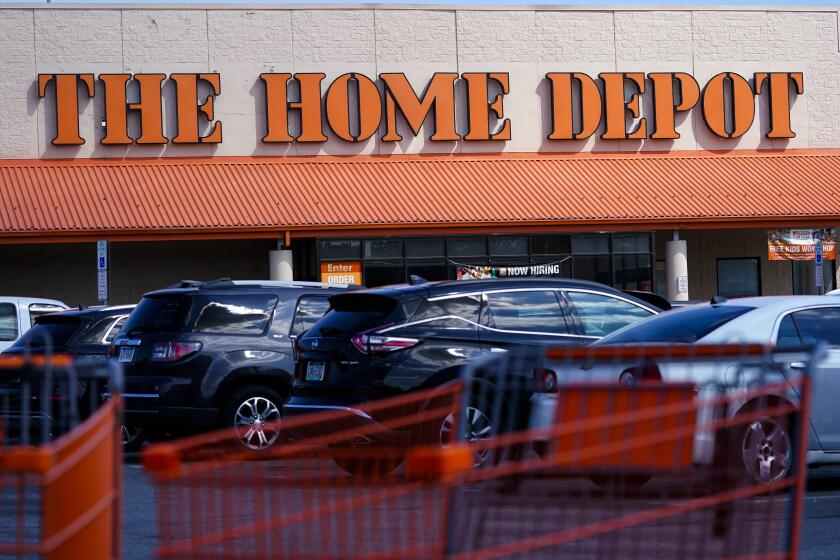Struggling Bed Bath & Beyond files for bankruptcy protection

UNION, N.J. — Bed Bath & Beyond — one of the original big-box retailers known for its seemingly endless offerings of sheets, towels and kitchen gadgets — filed for bankruptcy protection after years of dismal sales and losses and numerous failed turnaround plans.
The beleaguered home goods chain made the filing Sunday in U.S. District Court in New Jersey and said it will start an orderly wind down of its operations while seeking a buyer for all or some of its businesses. In the bankruptcy filing, the retailer said it anticipates closing all of its stores by June 30.
For now, the company’s 360 Bed Bath & Beyond stores and its 120 Buy Buy Baby sites as well as its websites will remain open to serve customers.
It listed estimated assets and liabilities in the range of $1 billion to $10 billion. The move comes after the company failed to secure funds to stay afloat.
In a statement, the Union, N.J., company said it voluntarily made the filing “to implement an orderly wind down of its businesses while conducting a limited marketing process to solicit interest in one or more sales of some or all of its assets.”
The store closings will put thousands of jobs at risk. The company had 14,000 workers, according to the court filing. That’s down from 32,000 employees as of February 2022.
Workers at the Trader Joe’s store in Oakland’s Rockridge neighborhood voted to unionize, but the national organizing effort suffered a setback.
Bed Bath & Beyond said it secured a commitment of roughly $240 million in financing from Sixth Street Specialty Lending Inc. to allow it to keep operating during the bankruptcy process.
“It’s the death of an icon. A lot of people have grown up with it, ” said Neil Saunders, managing director of GlobalData Retail. “It’s an institution in retailing, but unfortunately being an institution doesn’t protect you from financial woes.”
Bed Bath & Beyond was founded in 1971 and had for years enjoyed its status as a big-box retailer that offered a vast selection of sheets, towels and gadgets unmatched by department store rivals. It was among the first to introduce shoppers to many of today’s household items such as the air fryer or single-serve coffee maker, and its 15% to 20% coupons were ubiquitous.
But for the last decade or so, Bed Bath & Beyond struggled with weak sales, largely because of its messy assortments and lagging online strategy that made it hard to compete with the likes of Target and Walmart, both of which have spruced up their home departments with higher-quality sheets and beddings. Meanwhile, online players such as Wayfair have lured customers with affordable and trendy furniture and home décor.
In late 2019, Bed Bath & Beyond tapped Target executive Mark Tritton to take the helm and turn around sales. Tritton quickly reduced coupons and started to introduce store label brands at the expense of national labels, a strategy that proved disastrous for the retailer.
And the pandemic, which started shortly after his arrival, forced the retailer to temporarily close its stores. It was never able to use the health crisis to pivot to a successful online strategy as others had, analysts said. Although many retailers were grappling with supply chain issues a year ago, Bed Bath was among the most vulnerable, missing many of its 200 bestselling items, including kitchen appliances and personal electronics, during the holiday 2021 season.
The retailer ousted Tritton in June 2022 after two back-to-back quarters of disastrous sales. In recent months, the company, under the stewardship of recently appointed CEO Sue Gove, went back to its original strategy of focusing on national brands, instead of pushing its own store labels. But the company has had a hard time having suppliers commit to delivering merchandise because of the retailer’s financial woes.
This past holiday season, the stores were missing many key items, and it lost many customers, a problem that continued to plague the retailer through the winter and spring seasons.
Blake Mohs, 26, who worked as a loss-prevention employee at Home Depot in Pleasanton, was set to be married later this year, according to authorities.
The bankruptcy filing comes as the company’s shares have tumbled even more as speculation of an impending bankruptcy filing increased. Its financial performance has also deteriorated. In late March, it noted that preliminary results showed anywhere from a 40% to 50% decline in sales at stores opened at least a year for the quarter that ended Feb. 25.
The company also said in a Securities and Exchange Commission filing in late March that it planned to sell $300 million worth of shares to avoid a bankruptcy filing.
The home goods retailer had issued several warnings about a potential bankruptcy filing this year. In late January, it noted in a government filing it was in default of its loans and didn’t have the funds to repay what it owes. The company had said the default is forcing the company to look at alternatives including restructuring its debt in Bankruptcy Court.
Bed Bath & Beyond joins a growing list of retailers that have filed for bankruptcy so far this year, including party supplies chain Party City and David’s Bridal. The bankruptcy could offer a window of what’s to come in the retail industry, given the changing landscape and the increasing challenges in the U.S. economy.
During the depths of the pandemic, a number of retailers filed for Chapter 11 bankruptcy, including Neiman Marcus and J.C. Penney. But in 2022, there was a respite in retail bankruptcy filings as shoppers, flush with government stimulus money and a pile of savings, spent with abandon, helping to lift all types of retailers. But as credit tightens and inflation remains stubborn, shoppers have been tightening their purse strings in recent months, leaving struggling retailers such as Bed Bath & Beyond more vulnerable.
Bed Bath & Beyond had been trying to turn around its business and slash costs after the previous management’s new strategies worsened a sales slump. The company announced in August it would close about 150 of its namesake stores and slash its workforce by 20%. It also lined up more than $500 million of new financing.
Bed Bath & Beyond’s shares, which were trading at distressed levels, have also been on a turbulent run. It made a monstrous run from $5.77 to $23.08 in a little more than two weeks in August. The trading was reminiscent of last year’s meme-stock craze, when out-of-favor companies suddenly became darlings of smaller-pocketed investors.
But the stock fell back to Earth after Ryan Cohen, the billionaire co-founder of online pet-products retailer Chewy Inc. who purchased a nearly 10% stake in Bed Bath & Beyond in early 2022, sold off all his shares.
Shares were hovering close to 30 cents in the last few days. A year ago, shares were trading at around $17.
Bed Bath & Beyond said it expects to process returns and exchanges in accordance with its usual policies until May 24 for items purchased before Sunday. It also anticipates gift cards, gift certificates and loyalty certificates will be accepted through May 8. It will stop accepting coupons Wednesday.
More to Read
Inside the business of entertainment
The Wide Shot brings you news, analysis and insights on everything from streaming wars to production — and what it all means for the future.
You may occasionally receive promotional content from the Los Angeles Times.












